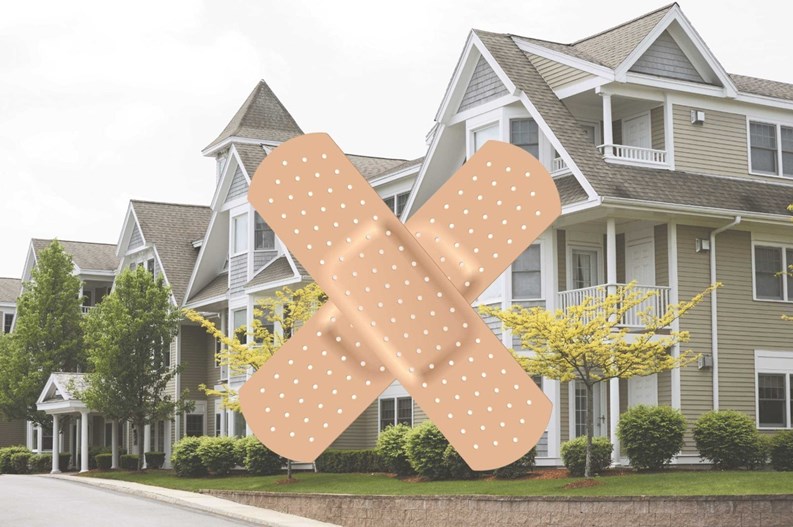For most people, few things are as stressful—or exciting—as buying a new home. That can be especially true for buyers and shareholders who sign up to be among the first residents in a newly renovated or constructed condo or co-op complex. There is the smell of the fresh paint, the shiny new stainless steel appliances, the untouched bath tiles and pristine hardwood floors—nothing quite beats that feeling of knowing that such a beautiful space is ours.
For some new residents, though, that initial rush of ownership ends way too soon, when the flawless façade turns out to hide sometimes devastating construction defects.
We read about it in the papers and hear about it from friends and acquaintances. Nearly everyone has heard at least one horror story about a new building with an impeccable appearance that hides bad plumbing, a leaky roof, sub-par windows or that just simply did not stand up to daily wear and tear. What happens to the unit owners and shareholders who find themselves in the midst of these problems and what should be done to avoid the situation altogether? As with anything, it’s all about looking before you leap—or in this case, sign financial documents that could hook you for thousands and even millions of dollars for a product simply not worth it.
The Test of Time
We’ve all heard the saying: they just don’t make ‘em like they used to. That’s how Wayne Bellet, owner of Manhattan’s Bellet Construction Co. Inc., describes the evolution he has witnessed in the building trade over the years. “I’ve lived in freshly built construction and now live in a postwar building and I’ve worked in all different variations thereof, including a church that is well over 100 years old,” says Bellet, whose firm specializes in maintenance, repair and restoration of residential, commercial and industrial properties throughout tri-state area. “They don’t build them like they used to. I visit buildings with roofs that my grandfather put on and they are still existing almost 100 years later.” That longevity is rarely found today where cost and quick turnarounds are such huge factors.
Roofing, for example, used to have fail-safes built into it, Bellet says. He describes a process called Built Up Roofing or BUR, which involved laying down layers of tar, then felt, then tar and felt, then tar and slag. “The redundancy of that system was so good that if any of these layers went bad, it had the next layer to back it up.” Today, he adds, “no one does the multiple ply anymore. It’s all single ply.” That means most roofs today only have 30 millimeters worth of protection from the elements versus layer upon layer of protective materials.
Sometimes the newer, cheaper, more accessible materials that have found their place in today’s building market lack the staying power and quality of materials past. Bellet cites the example of EIFS or Exterior Insulation & Finishing Systems found in many residential condos. There were many EIFS cases in New Jersey, and it was quite prevalent throughout the country. “It’s basically Styrofoam with stucco and wire mesh,” Bellet says. “You could put your hands through it.” The polystyrene of which it is comprised gives off “fumes” as the material ages, he says. All of this causes concern for homeowners who may find themselves coping with environmental fallout from less than exemplary materials.
Attorney Donald Brenner with the Lawrenceville-based law firm of Stark & Stark, notes that as problems go, water infiltration is a huge problem in the Garden State. Brenner, who is chair of the firm’s Construction Litigation Group, also says EIFS is a major defect as well. “By far the most common problem we encounter is water infiltration inside common elements that is caused by lack of proper flashings, failure to install proper “weep” mechanisms to allow water to drain out of wall cavities, and a failure to follow manufacturer’s installation specifications for installation of roofing, windows, exterior doors and deck/balcony waterproofing membranes. The damage caused by these deficiencies is often catastrophic and is entirely preventable,” he adds.
Bellet says he also sees the question of workmanship as a factor in the dissatisfaction of some property owners. In the rush to get buildings made quickly and cheaply, “everyone is overworked and underpaid these days,” Bellet says. “When I pull up to a building and see it’s a modern design built within the last ten years, I know there’s going to be some problems. People hire the cheapest architect who gives it to the lowest guy in the office who gives it to the cheapest general contractor and so on.”
Brenner has been handling EIFS cases at Stark & Stark for more than 20 years and the firm has an entire website devoted to the issue.
“Although there is no way to know for sure, I am confident that we have done more EIFS cases for plaintiffs than any other lawyers in New Jersey. Barrier EIFS is a face-sealed barrier to water penetration that has no secondary mechanism to allow incidental moisture that gets behind the EIFS to drain out. This product was designed to be used on concrete substrates where it wouldn’t matter if water infiltrated and reached the substrate,” he explained.
“Unfortunately, in the 1990’s, the EIFS manufacturers decided to try and expand their markets by selling barrier EIFS for use in wood framed, single family home and condominium construction. Given the workmanship and lack of effective supervision issues described above, the use of barrier EIFS in this type of construction caused extensive—sometimes catastrophic—damage to sheathing, framing and other property. The problem first surfaced in North and South Carolina in 1995. It spread all over the country. Tens of millions of dollars in damages caused by barrier EIFS were paid in New Jersey cases. Tens of millions more were paid in cases brought across the country.
Brenner noted that around 1997, EIFS manufacturers responded to the construction crisis by developing what are known as drainable EIFS products. These systems are designed to drain incidental moisture that gets behind the EIFS. If properly installed, many experts believe that these systems work. The problem is that the workers installing these systems are not familiar with or otherwise do not follow the manufacturer’s installation details and specifications. Therefore, he says, water still infiltrates and damages the underlying sheathing, framing and other property. “Our biggest cases have been cases involving drainable systems that were not installed correctly.”
And sometimes with new buildings, it’s a matter of working out the kinks in the system. Water damage is among the most common issues, agrees Vincent Hager of JGS Insurance based in Holmdel, New Jersey.
Avoiding the Problem
No one wants to deal with the headache of construction problems, especially after the papers have all been signed and the furniture delivered. The best way to avoid the issue entirely is to check, check and then check again to make sure that everything in the unit and the building is in order before the purchase is made. First, it’s important to know what to look for and what questions to ask. “It’s buyer beware,” says Bellet. “Call every friend and family member who has gone through this experience and everyone you know who’s experienced some nightmare of construction. Ring the alarm and say, ‘We need help and we need opinions.’”
Bellet then suggests calling a general contractor and service providers you think you may want to approach later for renovations or any areas you might be worried about. “Call the people you think you’re going to want to use before you buy the property,” he says. He has fielded calls from prospective property owners who want him to come out and take a look at a roof before they buy. “A little pre-emptive work goes a long way.”
It also helps to have thorough inspections so that even if there is no existing or immediate problem, any future potential problems can be documented. Brenner agrees. He suggests that a prospective buyer have an architect inspect the property before closing to make sure that anything that needs to be taken care of is taken care of.
When it comes to insurance, unit owners and shareholders should be diligent in understanding coverage as well, just in case an issue arises. Hager suggests obtaining “a fact sheet from the association’s insurance agent. This document should spell out who is responsible to insure the interior of the units and to what extent the association’s policy will cover interior damages. Even if the association’s policy insures what is known as ‘single entity’ insurance, which includes the interior walls, fixtures and cabinets if they were original standard options by the developer, the unit owner needs to purchase their own insurance.”
Sometimes insurance is not enough. In New Jersey, the issue of construction defects was addressed by passage of the New Jersey Home Warranty Act. However, Brenner admits that the act is flawed.
“The New Home Warranty Act is practically useless,” he says, noting that the firm’s Construction Law Blog features dozens of articles outlining problems with the act.
“The bottom line is the deck is stacked against the homeowner. You give up your biggest weapon which is having the jury hear your experts explain with testimony, photos and videos the cause and extent of your damages. You give up the right to discovery, especially discovery that shows design changes and material substitutions and other facts demonstrating that the developer or others knew about deficiencies but hid or overlooked them. You also give up your ability to conduct repeated invasive inspections of your property over a long period of time so you can show how conditions are worsening over time. You give up your rights against the millions of dollars of insurance policies available to fund your recovery,” he says.
When it comes to buying property, it is important to be extra vigilant these days, especially given the costs involved in purchasing prime new real estate. “Today you need to be sharper than ever,” Bellet says. In this economy, people “are dying to get rid of properties.” And while everyone loves to get a good bargain, Bellet adds, “you get what you pay for in real estate.”
What if a buyer has already moved into a unit in a new building and begins having problems with leaks, or other issues, where should the buyer turn? Brenner believes that the sooner a buyer deals with these issues, the better.
“If you are talking about a condominium, the owner should report the problems to the property manager and demand action be taken to find and fix the problem as well as any resulting damage. If that doesn’t work, hire an experienced attorney with knowledge of construction. The attorney will be able to refer the owner to a qualified engineering/architectural firm. Once the engineers/architect determine the cause of the problem and what needs to be done to fix it, counsel can try and negotiate a repair. If that fails, the owner can always have counsel institute suit.”
Turn to Your Advocates
Even if a buyer covered all the bases and did all the right things before purchasing their new property, the law of averages suggests there’s always still a possibility something was missed and a problem still could arise. Should that happen, it’s important to know where to turn.
“If the developer is still involved in the community, then I would definitely recommend (the unit owner) approach the developer first,” says Hager. “They should notify the association manager, if there is one, and have them reach out to the developer. The damage may be the result of a construction defect or faulty workmanship by a sub-contractor that the developer will want to address immediately.”
If, however, the developer is no longer active in the community or if they do not respond in a timely manner, “then the manager should go through the association’s insurance, if it is a condominium-style community. Some policies will only cover to the sheet-rock within the units of a condominium so the unit owner should also notify their condominium unit owner’s policy.” Any construction defects and maintenance issues are specifically excluded from the unit owner policy as well as the association’s insurance policies, Hager says, so these items would have to be addressed directly by the developer.
If problems are still ignored, it may be time to contact an attorney who can advise on options specific to the unit owner or shareholder’s issue. If it is something that affects whole areas or floors of the building, there may be value in neighbors talking to an attorney about approaching the developer or sponsor en masse. Finding an advocate who will work on behalf of the property owner can make all the difference.
For most people, the dream of moving into a bright, shiny and gorgeous new condo will end up being exactly what they hoped for. It never hurts, though, to be prepared and know how to protect oneself from those rare instances when that dream of home-ownership may start feeling like a nightmare.
Liz Lent is a freelance writer and a frequent contributor to The New Jersey Cooperator.







Leave a Comment